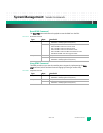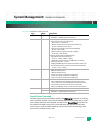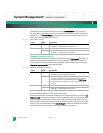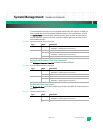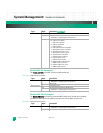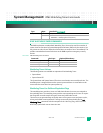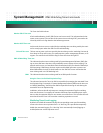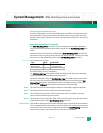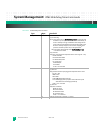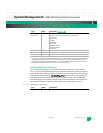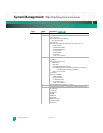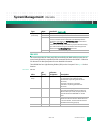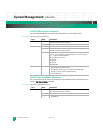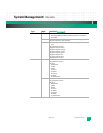
System Management: IPMC Watchdog Timer Commands
KAT4000 User’s Manual 10007175-02
9-28
The Timer Use fields indicate:
Monitor FRB-2 Time-out:
A Fault-resilient Booting, level 2 (FRB-2) time-out has occurred. This indicates that the last
system reset or power cycle was due to the system time-out during POST, presumed to be
caused by a failure or hang related to the bootstrap processor.
Monitor POST Time-out:
In this mode, the time-out occurred while the watchdog timer was being used by the moni-
tor for some purpose other than FRB-2 or OS Load Watchdog.
OS Load Time-out: The last reset or power cycle was caused by the timer being used to ‘watchdog’ the interval
from ‘boot’ to OS up and running. This mode requires system management software, or OS
support. The monitor should clear this flag if it starts this timer during POST.
SMS ‘OS Watchdog’ Time-out:
This indicates that the timer was being used by System Management Software (SMS). Dur-
ing run-time, SMS starts the timer, then periodically resets it to keep it from expiring. This
periodic action serves as a ‘heartbeat’ that indicates that the OS (or at least the SMS task) is
still functioning. If SMS hangs, the timer expires and the IPMC generates a system reset.
When SMS enables the timer, it should make sure the ‘SMS’ bit is set to indicate that the
timer is being used in its ‘OS Watchdog’ role.
OEM: This indicates that the timer was being used for an OEM-specific function.
Using the Timer Use Field and Expiration Flags
The software that sets the Timer Use field is responsible for managing the associated Timer
Use Expiration flag. For example, if System Management Software (SMS) sets the timer use
to “SMS/OS Watchdog,” then that same SMS is responsible for acting on and clearing the
associated Timer Use Expiration flag.
In addition, software should only interpret or manage the expiration flags for watchdog
timer uses that it set. For example, the monitor should not report watchdog timer expira-
tions or clear the expiration flags for non-monitor uses of the timer. This is to allow the soft-
ware that did set the Timer Use to see that a matching expiration occurred.
Watchdog Timer Event Logging
By default, the IPMC will automatically log the corresponding sensor-specific watchdog
sensor event when a timer expiration occurs. A “don’t log” bit is provided to temporarily
disable the automatic logging. The “don’t log” bit is automatically cleared (logging re-
enabled) whenever a timer expiration occurs.




